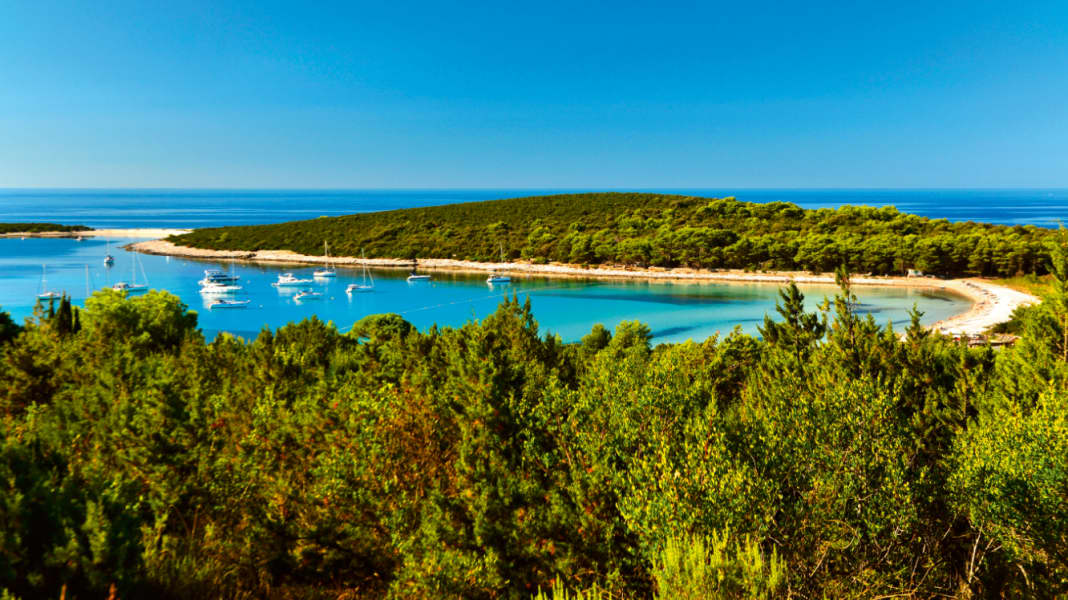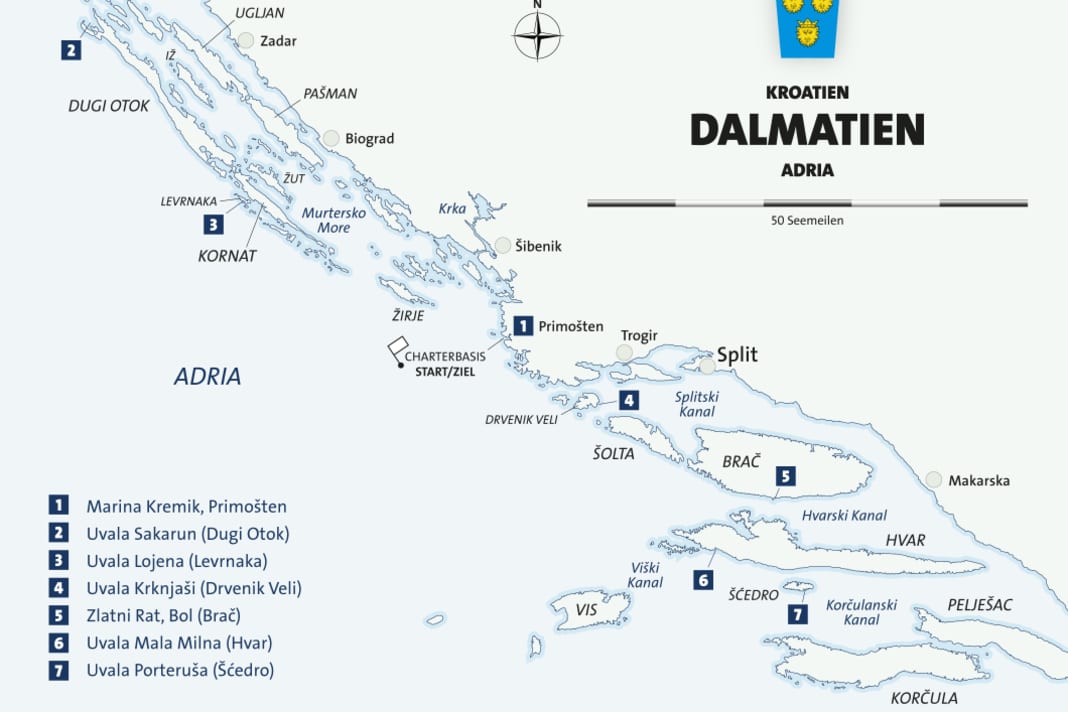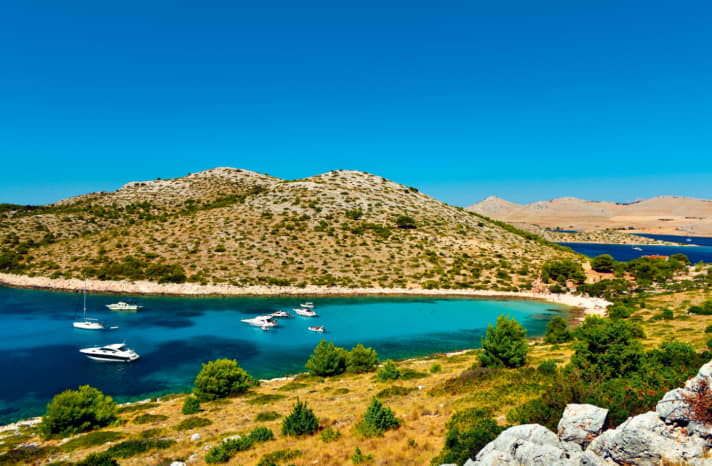







On our most recent trip to Croatia, we set ourselves a special challenge: The search for the most beautiful beaches in Dalmatia that are accessible by boat. It should be said in advance that there are of course no so-called dream beaches in Croatia with fine sand over a hundred metres wide. Anyone looking for such destinations should travel to the Bahamas - or to Amrum.
99 per cent of the Croatian coast consists of stone, rock and rugged cliffs. And yet you often hear from boaters that they have discovered a picturesque bay with a fantastic beach here or there. We followed these tips and planned the trip so that we could visit some of these rare "pearls" during a charter week. It is clear that with a coastline of no less than 4835 kilometres, we can of course only show a small section that makes no claim to completeness.
The start and finish of our trip is Marina Kremik near Primošten, where most of the country's charter fleets are based. Without exception, we want to head for beaches that are easily accessible and offer sheltered anchorages. We exclude the beaches of the Makarska Riviera, which are overpopulated by land-based tourism. Although we tried to optimise the route so that the distances between the individual spots were not too great, we still managed to cover a good distance overall. For a trip like this, it makes sense to book a boat that is as fast as possible, so that planing speeds of over 20 knots are no problem. In return, you can do without a bit of comfort - you want to go to the beach anyway!
The Adriatic is as smooth as glass as we leave Marina Kremik astern and head north-west. The conditions are perfect for planing. We decide to take advantage of the situation and sail through to the northernmost point of our journey, as it is not certain how long this phase of fine weather in late summer will last. We head along the east coast of Žirje and then into the Kornati islands from the south. Our first destination for the day is the northern tip of the island of Dugi Otok.
At the northern end of the Kornati islands, we are faced with a decision: should we head north along the sheltered east coast of Dugi Otok or take the slightly shorter route across the open sea along the rugged rocky coast in the west of the island? The west coast of Dugi Otok is home to the steepest cliffs in the Mediterranean, rising up to 166 metres vertically out of the sea at one point. At a distance of 22 nautical miles, there is no harbour, bay or other safe haven in which to hide if the weather takes a turn for the worse.
As the weather remains so temptingly calm, we decide to take the western route, past the steep cliffs of Dugi Otok, and go planing. The rock faces on the starboard side seem to go on forever. There is no bay anywhere where we could find shelter. I wouldn't want to run aground here in a storm. With this forbidding sight, it's hard to imagine that there could be a beach on the Croatian Adriatic - and certainly not here.
After a good hour, the rock faces gradually become flatter. We have almost reached the northern tip of Dugi Otok. We steer a course of 315° directly into Uvala Sakarun. What's that broad white stripe shining there? A mirage? No - the 300 metre wide apex of the bay is the finest sandy beach - and that in Croatia. We find a free mooring buoy in front of a floating line that separates the bathing area and tie up. Beneath our keel is six metres of the finest white sand. This must be celebrated with a swim in the turquoise-coloured water!

Sakarun Bay is on the one hand at the end of the world, but on the other hand not: a tarmac path leads from the beach northwards over a hill to the villages of Veli Rat and Soline on the other side of the coast. In Veli Rat, 2.5 kilometres away, there is a shop and a restaurant. If you have enough provisions on board, you won't miss anything in Sakarun. A visit to the beach bar "Amarcord" on the western shore of the bay in the evening is highly recommended.
Beatrice and Darko Bukarica look after their guests in the shade of old pine trees to the sound of classical music. Beatrice, who comes from Italy, conjures up Italian dishes with fresh fish and vegetables from the island. For vegetarians, she offers a wide variety of Mediterranean fruits. Her myrtle liqueur is said to bring beauty and eternal youth, just like in ancient Greece.
To the sound of the swell on the shore, the chirping of crickets and classical music, we enjoy one of the most beautiful beaches on the Adriatic under a sensational starry sky. No marina, however beautiful, can replace this experience. Late at night, nobody wants to take the dinghy back. We throw our clothes in and swim back on board with the boat in tow.
In the morning, we leave the paradisiacal beach and head north-westwards. Soon we have the 41 metre high Veli Rat lighthouse to starboard. Then we can already see the most beautiful wreck in the Croatian Adriatic! The iron, eroded by the salt water, gapes out of the sea in a rusty red colour. Although there is no beach at the wreck, there is a shallow anchorage.
There is virtually no wind and the sea is as smooth as glass. When I was here for the first time 20 years ago, the entire upper deck of the stranded cargo ship was still visible. It has now sunk so deep into the sand that only a piece of the bow is still sticking out of the water. The open holds and the aft deck are just below the surface of the water and are an excellent snorkelling spot.
On the east coast of Dugi Otok, which is not quite as steep and rugged as the west coast, we head south-east. This part of Dugi Otok is populated and every small village has a harbour. We make a short stop at the Zaglav ferry harbour. This is the only petrol station far and wide, and we fill our diesel tanks to the top just to be on the safe side. Five miles further south, we head across the Mala Proversa (Small Passage) between the islands of Dogi Otok and Katina and then head south again into the Kornati islands.
Our destination is the island of Levrnaka to the west of the main island of Kornat. Many boaters are familiar with Anica Bay, which cuts deep into the south and is home to two popular restaurants. However, we head for the seaward side of Levrnaka, where the lesser-known bay of Lojena is located. This is the only beach in the Kornati islands.
We drop the iron at ten metres and have one of the most beautiful bays in the Kornati islands almost to ourselves. Because the anchorage bay borders the open Adriatic Sea, where the water quickly drops to a depth of 90 metres, the water here is sensationally clear. It is probably the cleanest bay in the entire Kornati National Park and a must for every keen swimmer and snorkeller.
The beach consists of coarse gravel. Sometimes excursion boats come in during the day, sending a few dozen tourists ashore in the bay, who then populate the beach. But the hustle and bustle is short-lived. The excursion programme includes a fish picnic in the nearby konoba "Andrija". After an hour at the latest, the food is served there. And then the "seafarers" leave again.
We have the beach to ourselves for the whole afternoon and share the bay with three sailing yachts. Towards evening, the sky clouds over and a light swell rolls into the bay. A warm wind from the south brings humid air. It smells like jugo. As the southerly wind can last for several days, we might experience a restless night here.
Before it gets dark, we pull up the anchor, circumnavigate the island of Levrnaka in a clockwise direction and a quarter of an hour later moor deep in Anica Bay on the floating jetty in front of the "Levrnaka" tavern. Here, should the Jugo freshen up, we are as safe as in Abraham's lap.
Since 1980, Mladen Ježina and his son Daniel's rustic konoba has developed from a simple fishing hut into one of the best restaurants in the Kornati islands. You can moor up on mooring lines at the new floating jetty. Mooring is free of charge. Electricity costs a flat rate of 50 kuna. We find the last free table in the packed restaurant.
Owner Mladen says that we are lucky that a crew has cancelled, so we have a berth and a table. He serves us a starter platter full of maritime delicacies - from scampi to squid, tuna carpaccio and lobster tongs to sea urchin roe. He then brings us a freshly caught scorpion fish with chard potatoes - simply delicious. www.konoba-levrnaka.hr
The Jugo has brought warm and humid air, although the wind and swell are still moderate, so we can continue our journey southwards. The next spot on our list is known for its Caribbean flair. It is located in the south-east of the island of Drevnik Veli, just outside Split. With our glider, we manage the 48 nautical miles in just over two hours. We mainly take the "inner" route under the protection of offshore islands to minimise the swell.
When we arrive in the popular Krknjaš bay, the anchorage is already full. As the Jugo sends swell from the south-east, the inner berths in the shelter of the small islands are particularly popular. With our shallow draught, we find a well-protected spot between Mali Krknjaš and the jetty of Konoba "Krknjaši". The narrow beaches all around are rather rocky.
What counts here is simply being able to anchor over clean gravel. We take out our snorkels, masks and fins. The shallow water with its brightly coloured bottom is warmer than in deeper anchorages. Unfortunately, while snorkelling we also see that the many yachts have left their mark on this popular anchorage - in the form of beer cans and wine bottles.
After the excursion boats have left in the afternoon, we visit the "Krknjaši" tavern on the eastern shore and are pleasantly surprised. The restaurant's own garden with its splendour of flowers is a small Mediterranean paradise. The Spika family spoils guests with traditional fish dishes. Herbs and vegetables come from their own garden.
We head south-east to the most famous and largest beach in Croatia. Depicted on many tourist brochures, it gives the false impression that there are many more of them on the eastern shore of the Adriatic. The "Golden Horn" (Zlatni rat in Croatian) is located on the south coast of Brač near the town of Bol.

The sand protruding southwards from the island of Brač into the sea has the shape of a crescent. It stretches out for several hundred metres and consists of small, round pebbles that move with the current. The shape of the beach changes so that the tip sometimes points in one direction and sometimes in the other.
The jugo has subsided.
West of the "Golden Horn", we are reasonably protected from the south-east. We let the chain rattle between a dozen sailing yachts close to the beach. Despite the hundreds of plastic sunbeds on the beach, which are well frequented, the water is sensationally clean - thanks to a constant current.
Nevertheless, I would not recommend this place as a night-time mooring, as it is too unprotected for that. You could go to the nearby harbour of Bol for the night, but there we would be in the middle of the tourist stronghold.
So we head south-west, round the western tip of Hvar and pass through the Pakleni Channel between Hvar and Sveti Klement. We leave Hvar on our port side. As always, the small harbour of the popular tourist metropolis is mercilessly overcrowded. Although the southerly wind has calmed down, the swell still rolls into the bay and rocks the boats.
According to the weather forecast, the Jugo is due to take a break. But the probability of a bora is increasing. So we have to look for a bay that protects us from the north-easterly winds. And it should also have a beach. Mala Milna on the south coast of Hvar, where there is supposed to be a great sandy beach, comes into consideration. But the bay is relatively open and exposed to the swell.
The nearby island of Šćedro, where there are plenty of bays all around, seems much better. We round Šćedro in a clockwise direction and enter the deep Porteruša bay in the south-east. We find calm water in the very centre. We drop the iron at three metres and have the paradisiacal beach all to ourselves.
Unfortunately, a charter week is far too short for the Dalmatian coast with its endless number of cruising destinations. On the last day, we point our bow towards the north-west again. We enjoy gliding along the marvellous backdrop of the steep south coast of the island of Hvar. Attractive destinations pass us by, such as the mountain village of Sveta Nedjelia, where the winemaker Zlatan Plenković has given his village a harbour in whose hollow piers the best wines are stored.
Five miles further west, the beautiful beach of Mala Milna comes into view again to starboard. There are four sailing yachts and two small open motorboats moored in a field of buoys. The sailors are bobbing restlessly. The beach looks very attractive and has a special charm due to the huge boulders. The concessionaire of the buoy field comes towards us in a rubber boat: "Jugo will be coming. Come back later!"
A little disappointed, we turn away. And yet I'm grateful that the man wasn't thinking about his business first, but about our safety. "Yes, we'll be back later," I call back - even if it won't be until next year.

